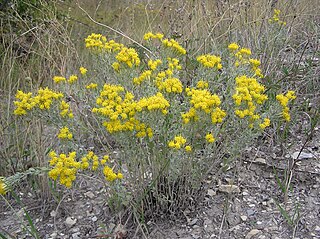
Pallenis is a small genus of flowering plants in the tribe Inuleae within the family Asteraceae. The name is derived from palea (chaff), referring to the chaffy receptacle.
Michel Félix Dunal was a French botanist. He was a professor of botany in Montpellier, France.

Alfred Grandidier was a French naturalist and explorer.

Cylindrocline is a genus of flowering plant in the family Asteraceae.

Euryops is a genus of flowering plants in the sunflower family. They are native mostly to rocky sites in southern Africa, with a few species in other parts of Africa and on the Arabian Peninsula. They produce daisy-like flowerheads from fern-like foliage. The name Euryops is probably a contraction of the Greek words ευρυς meaning 'wide,' and ὄψις meaning 'eye,' possibly referring to the large flowerheads compared to the narrow leaves.

Nidorella is a genus of African flowering plants in the tribe Astereae within the family Asteraceae.
Gibbaria is a genus of plants in the sunflower family, endemic to South Africa. The only known species is Gibbaria scabra.

Chiliotrichum is a genus of flowering plants in the family Asteraceae.
Crinitaria is a genus of flowering plants in the daisy family. Three species are accepted:

Galatella is a genus of flowering plants in the family Asteraceae, native to Europe, Asia, and northern Africa.
Laennecia or Laënnecia is a genus of flowering plants in the family Asteraceae. The plants are native to Mesoamerica, South America, and the southwestern United States. Common name is "horseweed."
Nolletia is a genus of flowering plants in the tribe Astereae within the family Asteraceae. The genus was named in honour of Jean-Antoine Nollet, French clergyman and physicist.

Podocoma is a genus of South American plants in the tribe Astereae within the family Asteraceae.
Millotia is a genus of small annual herbs in the tribe Gnaphalieae within the family Asteraceae.
Herderia is a genus of flowering plants in the sunflower family.

Lucilia is a genus of South American flowering plants in the tribe Gnaphalieae within the family Asteraceae.

Monarrhenus is a genus of plants in the sunflower family.

Panaetia, a genus in the Asteraceae (daisy) family, was first described by Henri Cassini in 1829 It is considered by Plants of the World Online and the Global Compositae Database to be a synonym of Podolepis Labil,. while GBIF states it as "doubtful". However, in 2021, the Western Australian Herbarium accepted Jeffery Jeanes new circumscription of the genus, together with two species of Panaetia as being found in Western Australia: Panaetia lessonii, and Panaetia tepperi. Jeanes distinguished Panaetia from the genera, Podolepis, Siemssenia and Walshia, using the following characters:
- the outer florets are all tubular; and
- the cypselas are minutely tuberculate and lack long finger-like papillae.

Podolepis lessonii is an erect annual herb native to Western Australia, belonging to the Asteraceae family.
Feliciadamia is a monotypic genus of flowering plants belonging to the family Melastomataceae, it contains one species, Feliciadamia stenocarpa(Jacq.-Fél.) Bullock.











